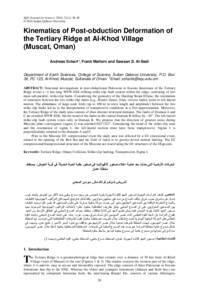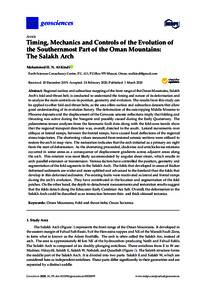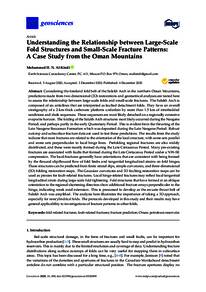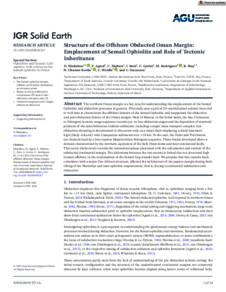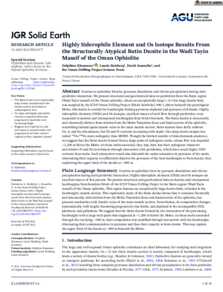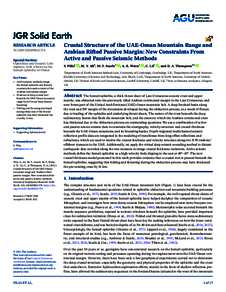Document
Phanerozoic geological evolution of Northern and Central Africa : an overview
Identifier
DOI: 10.1016/j.jafrearsci.2005.07.017
Source
Journal of African Earth Sciences. V. 43, 1-3, P. 83-143
Contributors
Country
Netherlands.
City
Amsterdam
Publisher
Elsevier Ltd.
Gregorian
2005-10-01
Language
English
English abstract
The principal paleogeographic characteristics of North and Central Africa during the Paleozoic were the permanency of large exposed lands over central Africa, surrounded by northerly and northwesterly dipping pediplanes episodically flooded by epicontinental seas related to the Paleotethys Ocean. The intra-continental Congo-Zaire Basin was also a long-lived feature, as well as the Somali Basin from Late Carboniferous times, in conjunction with the development of the Karoo basins of southern Africa. This configuration, in combination with eustatic sea-level fluctuations, had a strong influence on facies distributions. Significant transgressions occurred during the Early Cambrian, Tremadocian, Llandovery, Middle to Late Devonian, Early Carboniferous, and Moscovian. The Paleozoic tectonic history shows an alternation of long periods of predominantly gentle basin subsidence and short periods of gentle folding and occasionally basin inversion. Some local rift basins developed episodically, located mainly along the northern African-Arabian plate margin and near the West African Craton/Pan-African Belt suture. Several arches or spurs, mainly N-S to NE-SW trending and inherited from late Pan-African fault swarms, played an important role. The Nubia Province was the site of numerous alkaline anorogenic intrusions, starting in Ordovician times, and subsequently formed a large swell. Paleozoic compressional events occurred in the latest Early Cambrian ("Iskelian"), Medial Ordovician to earliest Silurian ("pre-Caradoc" and "Taconian"), the end Silurian ("Early Acadian" or "Ardennian"), mid-Devonian ("Mid-Acadian"), the end Devonian ("Late Acadian" or "Bretonnian"), the earliest Serpukhovian ("Sudetic"), and the latest Carboniferous-earliest Permian ("Alleghanian" or "Asturian"). The strongest deformations, including folding, thrusting, and active strike-slip faulting, were registered in Northwestern Africa during the last stage of the Pan-African Belt development around the West African Craton (end Early Cambrian) and during the polyphased Hercynian-Variscan Orogeny that extended the final closure of the Paleotethys Ocean and resulted in the formation of the Maghrebian and Mauritanides belts. Only gentle deformation affected central and northeastern African during the Paleozoic, the latter remaining a passive margin of the Paleotethys Ocean up to the Early Permian when the development of the Neotethys initiated along the Eastern Mediterranean Basins. The Mesozoic-Cenozoic sedimentary sequence similarly consists of a succession of eustatically and tectonically controlled depositional cycles. Through time, progressive southwards shift of the basin margins occurred, related to the opening of the Neotethys Ocean and to the transgressions resulting from warming of the global climate and associated rise of the global sea level. The Guinean-Nigerian Shield, the Hoggar, Tibesti-Central Cyrenaica, Nubia, western Saudi Arabia, Central African Republic, and other long-lived arches delimited the principal basins. The main tectonic events were the polyphased extension, inversion, and folding of the northern African-Arabian shelf margin resulting in the development of the Alpine Maghrebian and Syrian Arc belts, rifting and drifting along the Central Atlantic, Somali Basins, and Gulf of Aden-Red Sea domains, inversion of the Murzuq-Djado Basin, and rifting and partial inversion along the Central African Rift System. Two major compressional events occurred in the Late Santonian and early Late Eocene. The former entailed folding and strike-slip faulting along the northeastern African-northern Arabian margin (Syrian Arc) and the Central African Fold Belt System (from Benue to Ogaden), and thrusting in Oman. The latter ("Pyrenean-Atlasic") resulted in folding, thrusting, and local metamorphism of the northern African-Arabian plate margin, and rejuvenation of intra-plate fault zones. Minor or more localized compressional deformations took place in the end Cretaceous, the Burdigalian, the Tortonian and Early Quaternary. Recent tectonic activity is mainly concentrated along the Maghrebian Alpine Belt, the offshore Nile Delta, the Red Sea-East African Rifts Province, the Aqaba-Dead Sea-Bekaa sinistral strike-slip fault zone, and some major intra-plate fault zones including the Guinean-Nubian, Aswa, and central Sinai lineaments. Large, long-lived magmatic provinces developed in the Egypt-Sudan confines (Nubia), in the Hoggar-Air massifs, along the Cameroon Line and Nigerian Jos Plateau, and along the Levant margin, resulting in uplifts that influenced the paleogeography. Extensive tholeiitic basaltic magmatism at ∼200 Ma preceded continental break-up in the Central Atlantic domain, while extensive alkaline to transitional basaltic magmatism accompanied the Oligocene to Recent rifting along the Red Sea-Gulf of Aden-East African rift province.
Description
Journal of African Earth Sciences
Volume 43, Issue 1-3, October 2005, Pages 83-143
Volume 43, Issue 1-3, October 2005, Pages 83-143
ISSN
0899-5362
Category
Journal articles


